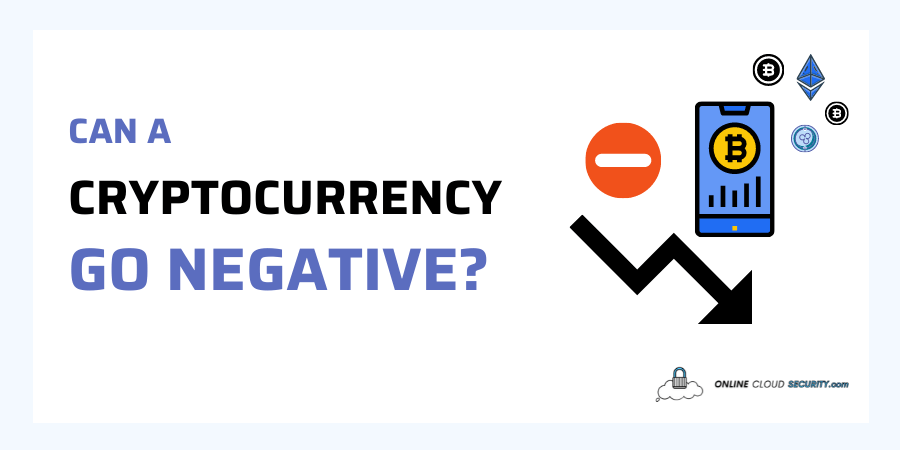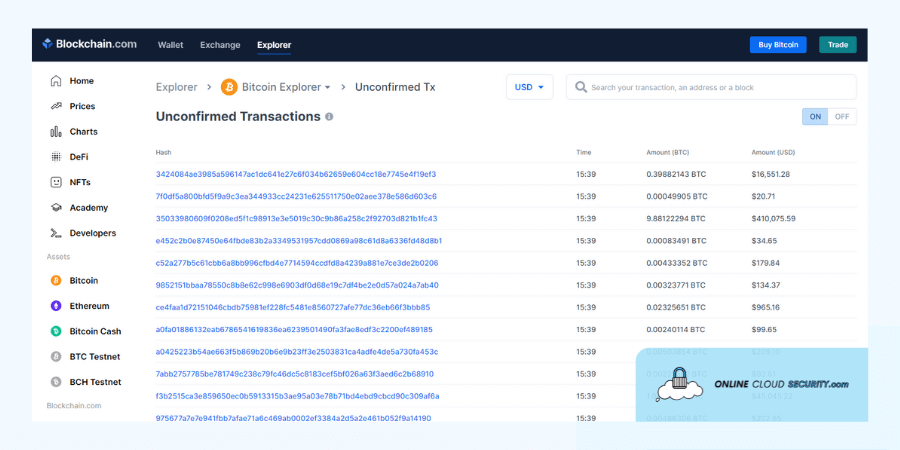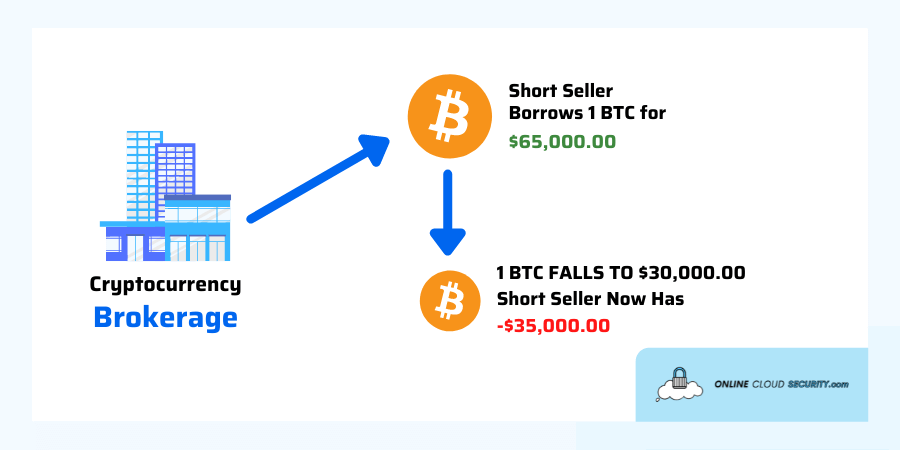

Dave Miller – Tech Enthusiast & Security Expert – January 11th, 2022

The value of cryptocurrencies and cryptoassets is determined by market forces and shifts with changes in demand and usage. Inquiring minds may question how the value of bitcoin and other cryptocurrencies is established and how much of a risk there is of losing money.
The value of a cryptocurrency can never go in the negatives. Coin and token prices are decided by the market value of the coin or token as well as any trading fees. Mining or providing services or products can also earn you cryptocurrency. Zero is the lowest possible value for those cryptocurrencies.
The value of a cryptocurrency can go up and down dramatically depending on the state of the market, but it can never go into the negatives. To put it another way, you’d be paying a third-party to remove your money or tokens from your possession. It’s impossible for any asset to be valued less than zero. Margin trading and short-selling, both of which are covered in the following section, might result in a negative account balance.
Before I go any further, it’s critical that you have a firm grasp of the mechanics of a transaction. For now, simply know what it is and why it can’t go negative. I’ll go into more depth about this in a later part.
Cryptocurrencies such as bitcoin are built on top of P2P networks (peer to peer). On a blockchain computer network, cryptocurrency calculations and transactions are carried out by a large number of nodes. A node can be run by anyone, and it doesn’t require any special training.
For each address, the transaction history and current amount are sent to each node. The file will read something like gave amount to as soon as a transaction is confirmed and it will be signed before the computer nodes validate the transaction with a certain algorithm. Once the transfer has been legally authenticated, it is combined with previous transactions to form a new data block in the archives.
The transaction is complete when the data block is added to the blockchain and can no longer be edited. The algorithm contains a code that rejects a transaction if there aren’t enough funds in the account. However, the input and output are being monitored, not the balance.

When a transaction is completed, the coin’s output is examined. In this case, the output would be added to the amount given in order to give you change if you needed a smaller amount. The best analogy would be if you paid with $10 money for a $8 item and received a $2 refund. The inputs and outputs of a transaction are validated each time a new block is added to the chain, rather than after each transaction.
By keeping track of every coin spent, this code ensures that no one is given more money than they have. In order to speed up the process of adding new blocks, the system may re-check each block for any incorrect transactions and store them. There are designated values for each output supplied to the chain and when one is consumed, the outputs receive a new sum that can’t be greater than what is now being used.
Nodes that are provided transactions that don’t adhere to the cryptocurrency enabler’s requirements will be unable to spend those coins. If the transaction’s output value is negative, the block containing it will reject it. As part of the blockchain system’s operation, it helps to prevent double-spending. There is no overdraft fee or need for it with this because there is no overspending with this.
This everything pertains to the currency’s value when it is spent, used or exchanged. Cryptocurrencies’ true worth, on the other hand, is decided solely by market forces. Bitcoin and other cryptocurrencies are valued by the people who buy and sell them. As a rule, the price of any cryptocurrency cannot go into the negatives whether purchasing or selling. Buyers and sellers can’t lose more than 100% of their money in most cases. Short-selling and margin-buying are two circumstances in which you can lose more money than you invested.
When making a deal, the price can’t go lower than zero, either. Customers and sellers can’t lose more than 100% of their money in most cases. Short-selling and margin-buying cryptocurrency are two examples of circumstances in which you can lose more than the amount of money you invested.
For the sake of argument, I’ll always use Bitcoin as an example because it’s the most well-known of the major cryptocurrencies.
There are no overdraft fees for bitcoin; however there is a fee for spending/mining. You can’t spend your Bitcoin unless you have enough to cover the fee as well. Consider this to be a charge for transferring your account to us.
The surcharge for using Bitcoin or some other types of crypto like Ethereum, where there are gas fees because of the amount of energy it requires to make a crypto transaction.
If the items you want to buy costs $2.50, but you want to pay with Bitcoin, you’ll probably need $3.05. In addition, if you don’t have the additional $0.55, the transaction will be refused. It’s clear from this that a cryptocurrency address can’t go negative in any direction.
There is no single authoritative institution like a bank or credit card firm that verifies transactions on the blockchain.
Instead, it is the miners that do so. Miners manually group blockchains and add them to a record that is easily available to track typical purchase histories via the bank, point-of-sale, and supplied receipts.
Then, the nodes save these for future reference. The miners are also responsible for verifying the validity of each transaction, in addition to adding it to the chain. In other words, they are looking for any instances of “double-spending.”
When sending money from one party to another without deducting any funds from the prior transaction, a user can easily copy online or electronic info. This is vital to prevent this.
To encourage miners to verify each transaction they receive, these fees are tacked on to the amount of money spent. Some miners get paid through the addition of these fees. As soon as the blocks are attached, they cannot be removed or reversed. It can take minutes, hours, days, or even weeks for a transaction to be confirmed depending on the size of the fee. It’s possible for miners to select which transactions to confirm first; therefore this is why it’s so slow. The faster the transaction is confirmed, the larger the cost.

Short selling entails borrowing an asset from another account holder, selling it at the current market price, and then repurchasing, returning it to the lender, and pocketing the difference when the price goes down.
Shorting cryptocurrency with the expectation that its value will raise means taking a loss that could never be recouped if the value of the cryptocurrency never goes back down. The more you lose, the more your cryptocurrency goes into the negatives. In order to avoid incurring further losses, most short sellers use limit or stop loss orders. If you don’t know what you’re doing, don’t short sell.
The second possibility entails making a purchase with the intention of selling it later. When you buy more currency than you can afford, you’re basically borrowing money from your chosen currency exchange.
It is possible to make a profit numerous times over if the price increases. Even if the value of your home may drop significantly over time, you may have to deposit more money in order to maintain your permissible borrowing ratio. It will automatically sell your coins to cover what you owe, and you may still owe more to cover the difference if the price drops too quickly.
In 2017 many crypto exchanges restricted margin trading due to the volatility of Bitcoin and other types of crypto. It was formerly possible to buy up to 20 times as many coins as you could afford on some markets. Long-term borrowing is not possible when buying on leverage.
A reduction in the coin price during your margin call period could result in a loss equal to or more than the amount you initially deposited. You could lose 20 times as much money as you invested.
Margin trading was shut down on several exchanges in 2018 while others limited the amount to the same amount as the U.S. stock market’s guidelines. However, keep in mind that we’re talking about cryptocurrency trade, not the worth of the coin itself. Futures contracts are a new tool for investors in 2020 to protect or restrict their losses.
Short and long positions can be somewhat bolstered by buying the opposing option contract in order to do so. If the value of a currency’s futures contract rises, you can recoup part of your losses. Experienced investors should only use these approaches, which are far too complex to cover in this short article.
Unlike many other assets, the value of a cryptocurrency can never be negative. Zero is the lowest amount of money that can be invested in real estate or an asset. Without short selling or margin trading, you can’t lose more than the amount of money you put in.
**Onlinecloudsecurity.com is a participant in the Amazon Services LLC Associates Program, an affiliate advertising program designed to provide a way for websites to earn advertising revenues by advertising and linking to Amazon.com and affiliated sites. As an Amazon Associate we earn affiliate commissions from qualifying purchases.**

Dave Miller is an IT Consultant for Online Cloud Security and has over 7 years of experience in the Information Technology space. He also specializes in repairing laptops & computers. In his spare time, he loves to talk about new technologies and hosts monthly IT and Cyber Security meetings in the Houston area.
Click any button down below to share this article on the following channels:

Online Cloud Security is here to recommend you the most secure devices, from laptops to smartphones, we only want to provide you with products that we have tested and used ourselves for online security. Every product that we recommend is heavily inspected and tested for security against hackers, viruses, malware, and any other intruders that may want to steal your information.

Online Cloud Security is here to recommend you the most secure devices, from laptops to smartphones, we only want to provide you with products that we have tested and used ourselves for online security. Every product that we recommend is heavily inspected and tested for security against hackers, viruses, malware, and any other intruders that may want to steal your information.
Your Trusted Source for Online Security